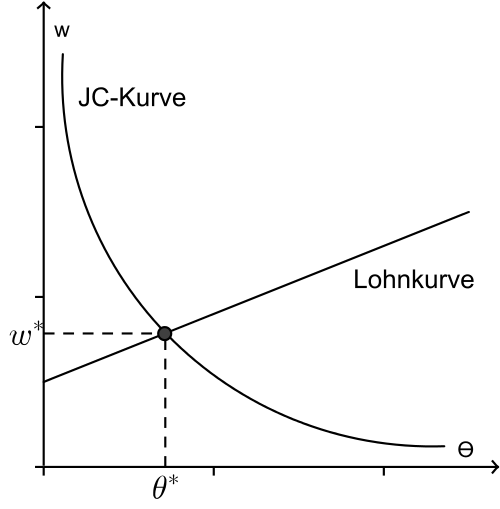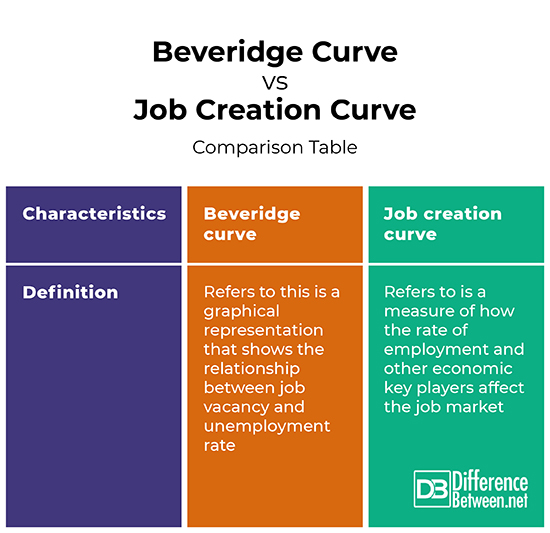Differences Between Beveridge Curve vs. Job Creation Curve
The world is currently struggling with high rates of unemployment. Although many nations are recovering from a deep recession and financial crisis, it is clear that the recovery process may take a while. High levels of unemployment, fiscal imbalances, low investment, low capital inflows and inflation are just some of the indicators of poor economic conditions. In the past, economists have studied the rates of unemployment and how other factors contribute to it. Among graphical representations used to show the unemployment rates in economies include the Beveridge curve and the Job creation curve.

What is Beveridge Curve?
Named after William Beveridge, this is a graphical representation that shows the relationship between job vacancy and unemployment rate. In this representation, the number of unfilled jobs is expressed as a part of the labour force. The intuition behind the curve is that the number of unemployment declines with an increase in vacancies.
The curve represents the negative relationship between unemployment and vacancies. This can be observed by movements in aggregate demand along the curve. As the economy contracts, the number of vacancies reduces, leading to high rates of unemployment. However, as the economy expands, the rate of unemployment is low.
Among factors that cause the Beveridge curve to change include
- Changes in the levels of skill mismatch
- Unemployment mismatch whereby unemployment arises because people cannot find a job that is a good fit. This causes the Beveridge curve to move to the right.
- Structural unemployment- This occurs when the skills in the labour market do not match with the skills employers are looking for. This shifts the Beveridge curve to the right.
- Economic uncertainty- When economies are uncertain, firms are hesitant to commit to hiring leading to a shift to the right in the Beveridge curve.
- The health of the economy- these include periods of recession or recovery.
- Changes in the rate of labour that is participating in the market
- Variance in the prevalence of long-term employment

What is Job Creation Curve?
This is a measure of how the rate of employment and other economic key players affect the job market.
The job creation curve determines the labor demand in bargaining and search models. It also shows an employer’s comparison of the benefit of maintaining a vacancy open and the expected cost. This means that a rise in wages must be offset by a decline in the rate of employment.
Employment levels and rates also vary with changes in wages, a trend that explains the heterogeneity of elasticity estimates in the labor demand literature.
Also, entrepreneurial abilities in the community determine the elasticity of the job creation curve. The job creation curve becomes slightly elastic in an instance where there is an increase in good business persons. On the other hand, the job creation curve becomes inelastic in an instance where good business persons are scarce.
Differences between Beveridge curve vs. Job creation curve
Definition
Beveridge curve refers to this is a graphical representation that shows the relationship between job vacancy and unemployment rate. On the other hand, job creation curve refers to is a measure of how the rate of employment and other economic key players affect the job market.
Beveridge curve vs. Job creation curve: Comparison Table

Summary of Beveridge curve vs. Job creation curve
Beveridge curve refers to this is a graphical representation that shows the relationship between job vacancy and unemployment rate. On the other hand, job creation curve refers to is a measure of how the rate of employment and other economic key players affect the job market.
- Difference Between Profit Center and Investment Center - July 2, 2022
- Difference Between Anti-Trust and Anti-Competition - June 6, 2022
- Difference Between Stocktaking and Stock Control - June 6, 2022
Search DifferenceBetween.net :
Leave a Response
References :
[0]Andy Beharrell. Unemployment and Job Creation. Macmillan International Higher Education, 1991.https://books.google.co.ke/books?id=UEhdDwAAQBAJ&pg=PA145&dq=Job+creation+curve+definition&hl=en&sa=X&ved=2ahUKEwjgj5_JwbvtAhWOlxQKHafXB2cQ6AEwAHoECAEQAg#v=onepage&q=Job%20creation%20curve%20definition&f=false
[1]Christopher Pissarides. Equilibrium Unemployment Theory, second edition. MIT Press, 2000.https://books.google.co.ke/books?id=M-3uCwAAQBAJ&pg=PA43&dq=Job+creation+curve+definition&hl=en&sa=X&ved=2ahUKEwjgj5_JwbvtAhWOlxQKHafXB2cQ6AEwAXoECAAQAg#v=onepage&q=Job%20creation%20curve%20definition&f=false
[2]John Keynes & General Press. The General Theory of Employment, Interest, and Money. GENERAL PRESS, 2019.https://books.google.co.ke/books?id=YRy0DwAAQBAJ&printsec=frontcover&dq=Job+creation+curve+definition&hl=en&sa=X&ved=2ahUKEwjgj5_JwbvtAhWOlxQKHafXB2cQ6AEwAnoECAMQAg#v=onepage&q&f=false
[3]Image credit: https://upload.wikimedia.org/wikipedia/commons/thumb/3/39/Intersection_of_wage_and_job_creation_curve.svg/500px-Intersection_of_wage_and_job_creation_curve.svg.png
[4]Image credit: https://commons.wikimedia.org/wiki/File:Beveridge_curve_US_2000_through_2015.svg
